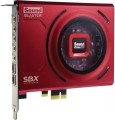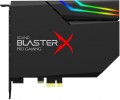Channels
The most advanced multi-channel audio format that a sound card is capable of outputting.
—
2. Standard stereo sound on two channels — left and right. This format allows you to provide a sense of surround sound (especially when using headphones), which is quite enough for most simple tasks. However, it noticeably loses to multi-channel sound in terms of the "immersion effect", which can be critical for demanding gamers and audiophiles.
—
5.1. The classic and most popular multi-channel surround sound format today: a centre channel, two front and two rear channels allow you to achieve a full-fledged “surround effect”, and a separate subwoofer channel provides rich bass sound.
—
7.1. The 7.1 format differs from 5.1 by the presence of two additional channels. There are several options for localizing these channels — for example, a pair of side speakers, a pair of additional speakers above the front ones, etc. Anyway, the 7.1 format provides a more reliable surround sound transmission than 5.1, but such cards are more expensive, and there is less specialized content for 7.1.
When choosing a sound card by the number of channels, it is worth considering such moments. Firstly, multi-channel options are capable of producing sound in simpler formats (for example, a 7.1 card can be used for 5.1 acoustics), and stereo sound output is support
...ed by all models in general. Secondly, modern multimedia software (in particular, codecs) allows you to output multi-channel audio through a card with fewer channels — for example, play 5.1 sound through a two-channel card with stereo speakers without quality loss. Thirdly, for the full-fledged operation of multi-channel sound, you will need not only a card, but also appropriate acoustics; therefore, it makes no sense to specifically look for a multi-channel model if you plan to use exclusively stereo speakers.Standards
Various standards and special digital audio technologies that the sound card is officially compatible with. For example, the Dolby and DTS standards in various variations are used primarily for multi-channel audio tracks in films, while DirectSound and EAX provide high-quality “surround” sound in games. In fact, the ability to work with one or another standard is largely determined by the software part of the system, and not by the characteristics of the sound card; however, official compatibility means at least the full compliance of the card with the requirements of the standard and the minimum risk of conflicts at the hardware level.
Additional power
The need to connect additional power to the sound card.
Most of both internal and external (see "Type") sound cards are powered directly through the connection connector (see "Connection interface"). At the same time, for normal operation of advanced models (for example, audiophile and gaming, as well as some DACs; see "View"), this power may not be enough, which requires an additional power source. In internal audio cards, it is carried out from the computer power supply, in external ones — directly from the 230 V network.
DAC resolution
The bit depth of the digital-to-analogue converter (DAC) of the sound card. In this case, DAC refers to a part of the circuit that converts digital sound data (machine code) into analogue pulses that are fed directly to an external device — speakers, headphones, etc. The bit depth is one of the main parameters (along with the sampling frequency) that describes the quality of the DAC: the higher it is, the more reliable the sound will be reproduced, the less distortion will be introduced into it during conversion.
16-bit DACs usually have entry-level sound cards — this is enough for good sound quality. In other cases,
24-bit converters are most common, and even for advanced models, in particular gaming ones (see "View"), they are almost mandatory.
Max. sampling rate
The highest sampling rate provided by the digital-to-analogue converter (DAC) of the audio card. For more details on the role of the DAC, see paragraph "Bit depth" above. Here we note that the quality of its work directly depends on the sampling frequency: the higher it is, the less distortion occurs when converting sound.
Usually in sound cards there are standard values for the maximum sampling rate:
44.1 kHz — corresponds to the sound quality of Audio CD;
48 kHz — DVD;
96 kHz — DVD-Audio 5.1;
192 kHz — DVD-Audio 2.0 (two-channel audio has a higher sampling rate than multi-channel audio for a number of reasons), the highest value in modern consumer-grade sound cards.
Another specific point is that the quality of sound played on a computer cannot be higher than the capabilities of a sound card. In other words, if an audio file is recorded at a higher sampling rate than the audio card can provide, its sound quality will be reduced: for example, on a 44.1 kHz card, even DVD-Audio sound will sound like an Audio CD. Therefore, if you want to fully enjoy high-quality sound, you should choose a model with a high sampling rate.
Dynamic Range
The dynamic range of a DAC is the ratio between the loudest sound that the converter can produce and the quietest. The wider the dynamic range — the richer the sound will be, the lower the likelihood that quiet sounds that complement the overall picture will be muffled during conversion. At the same time, it is worth noting that almost all modern sound cards provide a dynamic range that is quite sufficient for comfortable everyday use, and in many models this parameter may not be indicated at all. It is worth paying attention to it when choosing an advanced specialized audio card — for example, a gaming one (see "View"). The minimum for professional models is 90 dB, but in fact, among similar solutions, this figure is usually 120 dB or more.
Signal-to-noise ratio
This parameter determines the ratio of the "clean" sound produced by the DAC at the output to all extraneous noise. As such, it is a pretty strong indicator of sound purity. According to the signal-to-noise ratio, DACs in modern sound cards can be divided as follows:
up to 90 dB — initial level;
90-100 dB — average level, advanced "home" models;
more than 100 dB — professional level.
Max. sampling rate
The highest sampling rate that the analogue-to-digital converter (ADC) of a sound card can provide when digitizing sound. Without going into details, we can say that the role of this parameter is almost completely similar to the bit depth described in the paragraph above. And its standard values, found in modern audio cards, correspond to the following sound quality indicators:
44.1 kHz — Audio CD;
48 kHz — DVD
96 kHz — DVD-Audio 5.1
192 kHz — DVD-Audio 2.0 (two-channel audio has a higher sampling rate than multi-channel audio for a number of reasons), the highest value in modern consumer-grade sound cards.
More features
— Headphone Amplifier. The presence of a separate
headphone amplifier in the design of the sound card. Such equipment allows at least to improve the overall sound of the “ears”, as well as to implement various additional settings for such sound (for example, a separate volume control). And some headphones — primarily high-impedance Hi-Fi models — in principle cannot be used without special amplifiers.
— External control module. The presence
of an external control module in the design of the sound card. Such a module is actually a control panel with a wired connection; it doesn't give you the freedom of movement that a wireless remote control does (see below), but it's cheaper and often more convenient. So, the control module does not have to be in direct line of sight with respect to the audio card, and the length of the wire is often enough to place the device at the user's hand. However the set of adjustments placed on the external unit is usually limited to the most basic settings; however, even this, usually, is quite enough for comfortable use. In addition, the control unit often provides additional connectors for connecting headphones and a microphone. Among other things, this feature is especially convenient in games — it allows you to adjust the sound without distracting from the game itself. However, other types of sound cards can also be equipped with external modules (see "View").
...
— Remote control. A remote control is included with the sound card. Do not confuse this function with the external control module described above: in this case, we mean a classic wireless IR remote control, like those used in TVs. Such a device does not necessarily cover all the capabilities of the audio adapter, however, the range of functions of the remote control can be quite extensive. On the other hand, the need to control a sound card from a distance is extremely rare, and in most cases, the mentioned external module is enough for this. So models with a remote control are not widely used.
— Exit to the front panel. Ability to connect an internal sound card (see "Type") to the connectors on the front panel of the PC. To do this, a special connector (or several connectors) is provided on the board, which is connected to the corresponding connector (s) using a wire. The convenience of this feature is obvious: in desktop computers, the front panel is located closest to the user, and it is to it that it is easiest to connect peripherals that involve frequent plugging and unplugging, such as headphones and microphones. Actually, connectors for such devices are most often displayed on the front panel.
